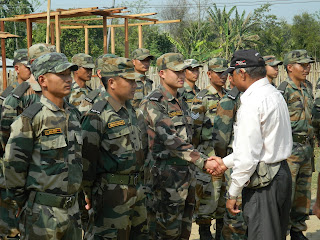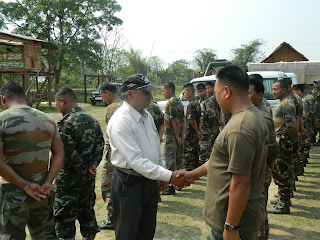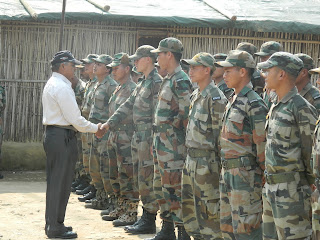
CHAPPIDI ABHIRATH REDDY
C/O COL GKS REDDY;
Secunderabad - 500 015.
Visit Assam & Arunachal Pradesh
Assam State
Assam ([æˈsæm], pronunciation (help·info); Assamese: অসম Ôxôm, /ɔxɔm/) is a northeastern state of India. Its capital is Dispur, located within the municipal area of Guwahati city. Located south of the eastern Himalayas, Assam comprises the Brahmaputra and the Barak river valleys along with the Karbi Anglong and the North Cachar Hills with an area of 30,285 square miles (78,438 km²). Assam is surrounded by six of the other Seven Sister States: Arunachal Pradesh, Nagaland, Manipur, Mizoram, Tripura and Meghalaya. Geographically Assam and these states are connected to the rest of India via a narrow strip of land in West Bengal called the Siliguri Corridor or "Chicken's Neck".
Assam shares international borders with Bhutan and Bangladesh; and cultures, peoples and climate with South-East Asia – important elements in India’s Look East policy. Assam became a part of the British India after the British occupied the region following the First Anglo-Burmese War of 1824–1826.
Assam is rich in culture, ethnic groups, languages/dialacts spoken and literature. It is known for Assam tea, large and old petroleum resources (the first oil reserves of India were discovered in Assam in the late 19th century), Assam silk and for its rich biodiversity. Assam has successfully conserved the one-horned Indian rhinoceros from near extinction, along with the tiger and numerous species of birds, and it provides one of the last wild habitats for the Asian elephant. It is becoming an increasingly popular destination for wildlife tourism, and Kaziranga and Manas are both World Heritage Sites. Assam was also known for its Sal tree forests and forest products, much depleted now. A land of high rainfall, Assam is endowed with lush greenery and the mighty river Brahmaputra, whose tributaries and oxbow lakes provide the region with a unique hydro-geomorphic and aesthetic environment.
Arunachal Pradesh /ˌɑrəˌnɑːtʃəl prəˈdɛʃ/ is a state of India. Located in northeast India, Arunachal Pradesh borders the states of Assam andNagaland to the south, and shares international borders with Bhutan in the west, Myanmar in the east and the People's Republic of China in the north. Itanagar is the capital of the state. China claims most of the state as part of Tibet and calls the disputed area South Tibet.
Arunachal Pradesh means "land of the dawn-lit mountains". Literally it means "land of the rising sun" (Sanskrit: Arun: Sun, Pradesh: state, province or region) in reference to its position as the easternmost state of India. It is also known as the "Orchid State of India" and the "Paradise of the Botanists". It is the biggest of the group of eastern states commonly known as the Seven Sister States. Like other parts of Northeast India, a majority of the people native to the state are of Tibeto-Burman origin. A large and increasing number of migrants have reached Arunachal Pradesh from many other parts of India, though no reliable population count of the migrant population exists, and percentage estimates of total population accordingly vary widely. Arunachal Pradesh has the largest number of regional languages among Indian states.
D + 2 (12 Mar 2013)
(a) The entire day was spent in crossing Lohit River on a ferry at Aloo Bari Ghat, travelling to a location somewhere in the Sadia sub Division of Tinsukia District in Assam, to meet the Troops deployed in CI Ops and also to meet some unit veterans from the area. (Photos 36 to 48)
Meeting the Veterans at a Post Somewhere in Sadia Sub Division of Tinsukia Dist
Speaking to Sub Golak Ch Gogoi (Retd), My Office Runner in 1982 - 83
Meeting the Troops
Meeting the Troops
Lunch with the Veterans
Signing the Company Visitors Book
(b) After lunch with the veterans, visited some civic action sites undertaken by the troops at a remote village, including a school building and a 9 KM long Gravel Track to connect the village with the main road and returned to the unit location by evening. (Photos 49 & 50 ‘A’)
School Building Constructed by Troops in a Remote Village as Part of Civic Action
D + 3 (13 Mar 2013)
(a) The morning was spent in visiting some tourist sites like ‘Pali Language Museum’ at Chongkham (Gunanagar), the ancient capital of Khamti Kingdom in Namsai Sub Division of Lohit District (Photos 50 to 53) and Golden Pagoda located at Tengapani in the same District (Photos 54 to 58).
The Famous 'World Peace Pagoda' Located at Gunanagar, the Ancient Capital of Khamti Kingdom
PALI LANGUAGE MUSEUM, CHONGKHAM:
Pali Vidhyapith is located at Chongkham, the erstwhile capital of Khamti Kingdom, in Namsai sub Division of Lohit District. The Vidhyapith is an English Medium School with CBSE syllabus. However, they also give prominence to Pali, the ancient language of Buddhists. The Vidhyapith is maintaining a beautiful “PALI LANGUAGE MUSEUM” which contains various ancient Buddhist scriptures in Pali language, besides other artifacts pertaining to Buddhist culture and ancient Khamti Kingdom.
There are several Buddha-Vihar, locally called CHONG in the Khamtis area. The world Peace Pagoda located in a river island at Chongkham is ideal for meditation in front of Buddha statues that surround the inner core of the vihar. The Khamti Raja's Chong at Guna Nagar at Chongkham is famouse for relics of Gautama Buddha. All the CHONGs and statues of Lord Buddha are made in the Thai-architectural style. There is no ban to visit these CHONGs.
Pali Language Museum at Chongkham (Gunanagar)
Pali Language Museum Chongkham
GOLDEN PAGODA, TENGAPANI, ARUNACHAL PRADESH
The newly-built majestic Golden Pagoda (Buddist Temple) – known as ‘Poi Lu Kongmu Kham’ in Tai-Khampti dialect has been inaugurated on 24 Feb 2010 in Tengapani village, Namsai Sub Division of Lohit District, Arunachal Pradesh with thousands of devotees of Lord Buddha from various parts of the country and abroad attending the religious ceremony. Golden Pagoda was created by over 300 Myanmarese architects and skilled masons under the supervision of two experts from Myanmar.
In Front of Golden Pagoda
At the Ashoka Pillar next to Golden Pagoda
At the Golden Pagoda
Main Entrance Gate to Golden Pagoda Complex
(b) Thereafter, visited the troops deployed in CI Ops somewhere in Lohit & Chang Lang Districts of Arunachal Pradesh and Tinsukia District of Assam, before proceeding to Tinsukia and Dhuliajan towns to meet some Jawans and friends (Photos 59 to 69). Left for Dimapur in Nagaland by Tinsukia Mail at night.
Watching the Mortar Platoon Training
Meeting Troops Deployed in CI Ops Somewhere Arunachal Pradesh
Meeting Troops Deployed in CI Ops Somewhere in Arunachal Pradesh
Meeting Troops Deployed in CI Ops Somewhere in Arunachal Pradesh
Meetin Troops Deployed in CI Ops Somewhere Assam
Meetin Troops Deployed in CI Ops Somewhere Assam
Meetin Troops Deployed in CI Ops Somewhere Assam
With a Friend Mr Pitambar Reddy at Dhuliajan in Tinsukia Dist
Note:- Information about the places given in this blog is Courtesy Wikipedia, the free Encyclopedia



















No comments:
Post a Comment